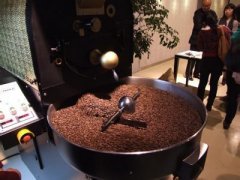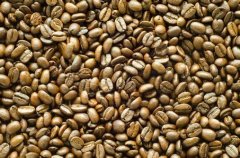A brief introduction to the Market Price of Brazilian Fine Coffee Bean varieties with Caramel flavor

The old bourbon coffee is grown on some estates in the Serrado district of MinasGreais in southeastern Brazil. These estates, such as Caping Blanco (CapinBranco) and Vista Allegre (VistaAllegre), grow old varieties of bourbon coffee on the market. Although they come from the same area, these coffees have their own characteristics. Capingblanco coffee is smoother than Vesta Allegre coffee, while Vesta Allegre coffee is strong and black, both of which have lower acidity. However, like all Brazilian coffee, they are most suitable for drinking when they are fresh and tender, because the older they are, the more acidic they are. These coffee growers have organized themselves into the Brazilian Special Coffee Association (theSpecialityCoffeeAssociationofBrazil).
In the first three or four years before the coffee tree began to bear fruit, the beans were small and curved, with excellent flavor, and became the "Bourbon Santos". After that, the beans became bigger, flat in shape, no longer bent, and became "flat bean Santos". The flavor was not as good as before. Brazilian coffee can be found everywhere in Taiwan, but most of them are flat bean Santos. In fact, there are still high-quality coffee beans in various parts of Brazil, which will be sold on the market under their own name and are no longer commonly known as "Brazilian coffee." Some farms still retain the old bourbon species, with small particles of raw beans, obvious bending, red silk on the central line and the nickname "red center". Bourbon beans taste full, strong aroma, like drinking old wine, it is well worth a try
The Carvalho Dias family is the founding member of the Brazilian Fine Coffee Association. The persistence of coffee quality and the maintenance of the environment are obvious to all. In the family farm, the use of natural waterfalls to develop pollution-free hydropower, self-sufficient electricity demand (another award-winning member of the family is named Waterfall Manor after this waterfall) Construction of churches, classrooms, nurseries, medical stations, maintenance of primitive forests of native animals and plants, and continuous afforestation.
In the case of the Queen's Manor, the environmental protection is quite thorough. Because of the high terrain and non-plain terrain, it is impossible to use machines to harvest, and the fruits can be harvested completely by hand. And plant low-yield and high-quality bourbon species, as the essence of high-quality Brazilian coffee on behalf of the manor! This batch of Queen's Manor (Fazenda Rainha) belongs to the Carvalho Dias family and has been around for more than 116 years.
Brazil has also proved to be able to produce gourmet coffee and small quantities of coffee, and the local boutique coffee can not only be provided by small-scale coffee farmers. The main coffee producing areas in Brazil are Sulde Minas South Minas, Matas de Minas Minas South East Mountain Forest, Cerrado Hirado, the north-central mausoleum of Chapadas de Minas Minas, Mogiana, Paran á Parana and Bahia Bachia. There are both traditional varieties and variants, such as Bourbon, Mondo Novo Mondonovo, Icat ú Ikatu, Kaduai, Iapar, cultivated card Taiyi.
Producing area: Alta Mogiana, Sao Paulo Paulo
Estate: Fazenda Rainha Manor (Queen Farm)
Variety: yellow bourbon (Yellow Bourbon)
Altitude: average 1150 ft 1350 m
Treatment: natural sun drying
Flavor features: balanced sweet, creamy smooth, orange, apricot and other fruit flavor, chocolate, caramel flavor.
There are many kinds of Brazilian coffee, it is difficult to say that it has any special flavor, no outstanding advantages, no obvious disadvantages, most of them are medium acid, taste lubrication, mainly mild and smooth, mellow and sweet, its softness makes it mixed with other coffee beans, the taste will not change much; and the oil is relatively rich. So Brazilian coffee beans are best mixed with other coffee beans to make espresso, which forms a golden foam on the surface of espresso and gives the coffee a slightly sour taste and a long finish. In fact, all the big coffee roasters have some coffee from Brazil in their blends.
The success of the reform has increased the confidence of coffee farm operators. Coffee farms in Brazil will choose solarization, half-sun, washing, half-washing or honey treatment, which is very popular in the boutique coffee industry in recent years, according to the dry and humid climate. To show the best regional flavor. For example, Serrado in the Midwest of Minas, where the humidity is ultra-low, is still mainly in the sun. The manor here believes that as long as the sun is strictly controlled, it can best highlight Serrado's unique nutty flavor and sweetness, while half-sun has become a supporting role in Serrado. The manor in South Minas is the most inclusive, using half-sun, sun and water, respectively. Brazil has such a variety of treatment options that it is rare in the world besides the coffee's hometown of Ethiopia.
Important Notice :
前街咖啡 FrontStreet Coffee has moved to new addredd:
FrontStreet Coffee Address: 315,Donghua East Road,GuangZhou
Tel:020 38364473
- Prev

A brief introduction to the history and culture of the origin and development of balanced and supple Brazilian boutique coffee beans
Santos is a descendant of the bourbon species, hence the name for the port of Santos export. In the first three or four years before the coffee tree began to bear fruit, the beans were small and curved, with excellent flavor, and became Bourbon Santos. After that, the beans became bigger, flat in shape, no longer bent, and became flat bean Santos, and the flavor was not as good as before. Brazilian coffee can be found everywhere in Taiwan, but most of them
- Next

A brief introduction to the planting situation of Brazilian boutique coffee beans, geographical location, climate and altitude
Product name: Brazil Yellow bourbon Brazil Chacal Estate Yellow Bourbon gauge: 227g raw bean production country: Brazil production area: Minas Minas Llicinea Manor: waterfall Manor species: yellow bourbon Grade: 2 d/300gr, 17-18 mesh height: 1200m ~ 1380m treatment: sun baking degree: medium and deep baking taste characteristics: sweet and smooth
Related
- Detailed explanation of Jadeite planting Land in Panamanian Jadeite Manor introduction to the grading system of Jadeite competitive bidding, Red bid, Green bid and Rose Summer
- Story of Coffee planting in Brenka region of Costa Rica Stonehenge Manor anaerobic heavy honey treatment of flavor mouth
- What's on the barrel of Blue Mountain Coffee beans?
- Can American coffee also pull flowers? How to use hot American style to pull out a good-looking pattern?
- Can you make a cold extract with coffee beans? What is the right proportion for cold-extracted coffee formula?
- Indonesian PWN Gold Mandrine Coffee Origin Features Flavor How to Chong? Mandolin coffee is American.
- A brief introduction to the flavor characteristics of Brazilian yellow bourbon coffee beans
- What is the effect of different water quality on the flavor of cold-extracted coffee? What kind of water is best for brewing coffee?
- Why do you think of Rose Summer whenever you mention Panamanian coffee?
- Introduction to the characteristics of authentic blue mountain coffee bean producing areas? What is the CIB Coffee Authority in Jamaica?

